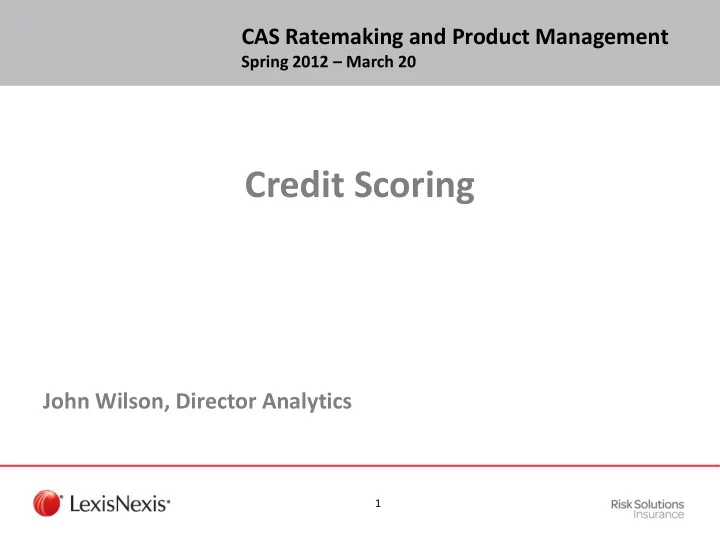

CAS Ratemaking and Product Management Spring 2012 – March 20 Credit Scoring John Wilson, Director Analytics 1
What are Credit-based Insurance Scores? A numeric representation of relative insurance claim risk based on consumer credit details Most are “bowling” scores (higher scores indicate lower risk) but some are “golf” scores An objective, consistent, and effective tool used with other risk factors (ex. prior claims) to better estimate future claims risk and cost 2
What Data is Considered? How long you’ve had credit established The numbers and types of accounts you hold Indications of recent activity, such as inquiries and newly opened accounts The degree of utilization on accounts, and Payment history, including timeliness as well as adverse public records or collection items 3
What’s Not Considered? Factors such as gender, marital status, age, address, occupation, or education Inquiries made for account review, promotional, or insurance or consumer disclosure purposes Multiple inquiries for auto finance or mortgage finance when made within a 30 day period Collection items designated as medical on the credit report 4
How Do They Differ From Lending Scores? Insurance Models ≠ Financial Models Insurance Models are developed on Financial Models are developed on historical insurance losses bad debts or 90+ delinquencies Insurance Scores rank order claim Financial Scores rank order the odds frequency or a similar metric of credit “bads” Insurance scores are not as Financial scores are more sensitive to dependent on derogatory behavior credit delinquencies 5
How is Their Use Regulated? LexisNexis is a Consumer Reporting Agency under the federal FCRA and state analogues We provide disclosure and facilitate dispute resolution Because insurance is regulated at the state level, we conform to specific state statutes, guidelines, and regulations (ex. NCOIL) We work with state insurance departments to explain our models and try to gain approval for their use We are not an insurance company; we don’t set rates or provide advisory services 6
Insurance Credit Score Trends • We track two different populations • Activity in the Market (drawn from our NCF transactions), and • A large retro sample (proxy for existing business) • What changes are we seeing? 7 7
National Attract Auto Score Trends – New Business 825 800 775 750 Northeast 725 Midwest 700 South 675 West 650 US Total 625 600 575 2007 2008 2009 2010 2011 • All regions are seeing small, gradual score improvements • Western and Southern regions improved more from 2009 to 2010 8
Attribute Trends – Existing Business AA30 SCORE DEROG PUBLIC RECORDS 1.20 1.20 1.15 1.15 1.10 1.10 1.05 1.05 1.00 1.00 0.95 0.95 0.90 0.90 0.85 0.85 0.80 0.80 Overall Overall • Attract Auto 3.0 Scores on this large retro sample get slightly better each year • Adverse Public Records are up overall, but annual increase is relatively small 9 9
Attribute Trends – Existing Business AVG ACCOUNT AGE # INQUIRIES AVG DEBT BURDEN (MONTHS) 1.20 1.60 1.20 1.10 1.50 1.15 1.00 1.40 1.10 0.90 1.30 1.05 0.80 1.20 1.00 0.70 1.10 0.95 0.60 1.00 0.90 0.50 0.90 0.85 0.40 0.80 0.80 Overall Overall Overall • Inquiry counts have dropped dramatically, while average trade age has increased • Revolving utilization has steadied after an initial drop; bank / consumer changes 10 10
Recommend
More recommend